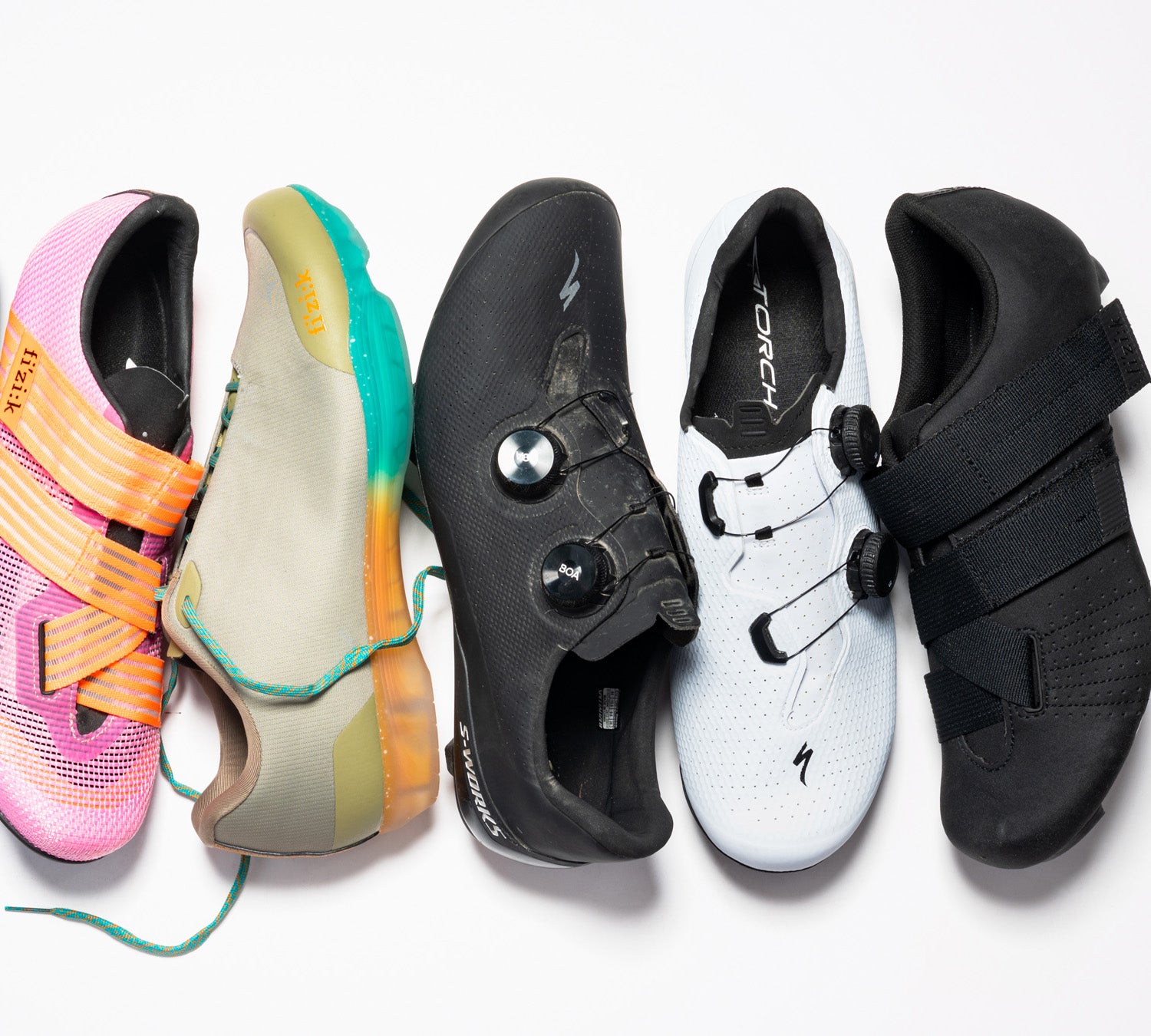The contact points between the rider and a bicycle are some of the most important aspects of riding a two-wheeled steed (think saddle, grips, pedals, and, yes, shoes). The bike shoe category has widened dramatically in the past few years to include everything from the highest-performance road shoes to versatile gravel kicks to flat pedal pumps designed for rugged mountain bike rides.
Our testers rode hundreds of miles to find the best cycling shoes for fit and performance across all of these categories. From sleek, clipless shoes for dancing on dirt to the mountain biking equivalent of steel-toe construction boots for your own personal Redbull Rampage, we hand-picked the following options that meet the needs of modern riders.
Updated July 2025: We added 8 new picks, including our new favorite MTB and road cycling shoes—the Crankbrothers Mallet BOA and Specialized Torch 3.0. We also updated pricing and info on previously listed bike shoes.��
Best Bike Shoes at a Glance
Best Mountain Bike Shoes
- Best Do-It-All Clipless Shoe: Crankbrothers Mallet Boa ($200)
- Best Flat Pedal Shoe: Pearl Izumi X-ALP Launch (
$150$90) - Best Downhill/Enduro Shoe: Shimano GE7 ($180)
- Best Protection: Ride Concepts Tallac Mid BOA MTB ($220)
Best Road Cycling Shoes
- Best Overall: Specialized Torch 3.0 ($280)
- Best Performance: Shimano RC903S ($475)
- Best On a Budget: Fizik Beat Tempo ($180)
Best Gravel Shoes
- Best Gravel/XC Shoe: Giro Sector ($240)
- Best High-End Gravel/XC shoe: SIDI Physis ($399)
- How to Choose Bike Shoes
- How We Test
- Meet Our Lead Testers
Best Mountain Bike Shoes
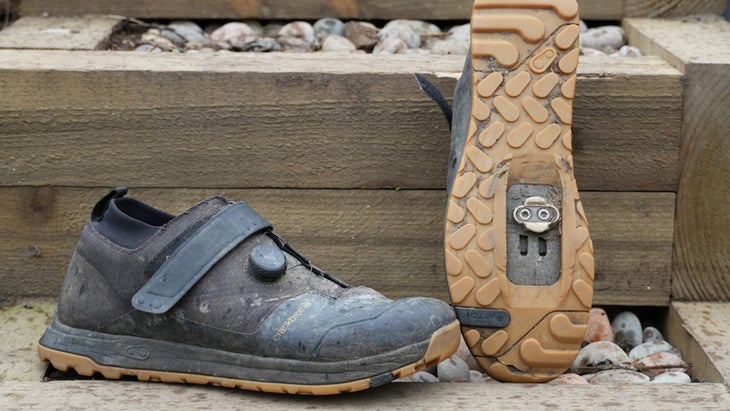
Best Do-It-All Clipless Shoe: Crankbrothers Mallet BOA Clip-In Shoes
Available sizes: US M 6 – 14
Pros and Cons
⊕ Very comfortable
⊕ Super durable
⊕ Supremely adjustable fit
⊗ Limited ankle coverage
Technically, the Mallet is Crankbrothers’ offering for gravity-focused endeavors—downhill, park, and enduro racing—but these well-padded shoes are lightweight and breathable enough that if you loathe the ballet slipper look, they do just fine for any riding this side of XC racing.
While the brand makes their own pedals, the Mallet utilizes the brand’s ‘Match’ design philosophy: a long and wide cleat pocket that’s designed to both shed mud and aid cleat engagement/release regardless of your preferred clipless pedal. The shoes come with shims to optimize your pedal-cleat-shoe interface, but in a nod to their own pedals, and as an encouragement for you to use them, the Mallets come with Crankbrothers’ own cleat already installed in a neutral position.
The shoes are burly yet offer a comfortable amount of padding, with silicone gripper dots in the heel cup for a secure fit. They also utilize just the right amount of ventilation for good breathability on all but the hottest days. The medium stiff midsole combined with a nicely rockered sole makes for exceptional comfort both on and off the bike. All these features, combined with the ability to dial in an exact fit with the BOA dial, make these shoes a winner. Our only complaint: We wish they offered a little more ankle coverage.
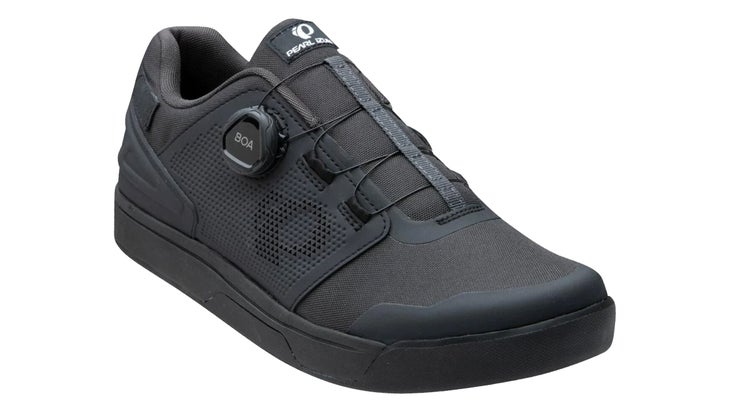
Best Flat Pedal Shoe: Pearl Izumi X-ALP Launch
Available sizes: EU 39 – 49
Pros and Cons
⊕ Lightweight
⊕ Optimal for narrow feet
⊗ BOA loosened on longer rides
⊗ Soles not as grippy as Five Ten or Ride Concepts
The X-ALP Launch is an affordable flat pedal mountain bike shoe that takes the cake when it comes to a lightweight, flexible feel. The shoe features a stout Cordura mesh upper with a single BOA dial that allows for quick fit adjustments. We found that the X-ALP has a low-to-medium internal volume that runs a bit narrower in the toe box than other brands. An EVA foam midsole is paired with an outsole featuring Goodyear rubber molded with a chevron pattern, designed to offer good grip and traction.
Despite the use of brand-name rubber, the X-Alp is not the grippiest shoe out there. But that’s not necessarily a bad thing: this allows for easy micro foot adjustments compared to the locked in feel of some other shoes on our list. What the sole lacks in grip, it makes up for with impressive lightweight feel and efficient power transfer. In our testing, the shoes excelled on longer trail rides in dryer weather where heat and foot fatigue can be issues. And while the single BOA loosened up a bit on our longer rides, it’s fairly easy to tighten up on the fly. This might not be the shoe you want for bike park laps, but it hits the mark for those who prefer the versatility of a flat pedal shoe versus clipless for hot cross-country and trail rides.
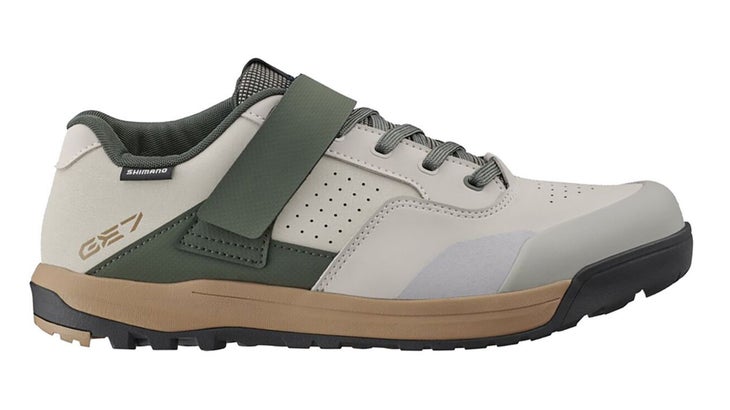
Best for Downhill/Enduro Riding: Shimano GE7
Available sizes: EU 38 – 48
Pros and Cons
⊕ Excellent off the bike grip
⊕ Longer cleat channel
⊕ Roomy toe box
⊗ Runs a little hot
The Shimano GE7 is one of our favorite clipless MTB shoes. The SPD-compatible GE7 features laces with a velcro instep strap for precise fit, a burly outsole for enhanced grip, raised and padded ankle collar, enhanced toe cap, and a reinforced fiberglass midsole (TORBAL 2.0, a midsole technology that provides targeted rigidity and flexibility) for stellar pedaling efficiency.
Originally designed for Enduro style racing, this shoe is meant for big days that could involve a fair bit of hike-a-bike as well as full-tilt boogie pedaling. Translation: it’s super comfortable and holds up well on longer rides thanks to a nice balance of stiffness and flex in the sole, plus a relaxed–dare I say ‘roomy’?–toe box to give those little piggies room to stretch out. The traction is excellent when you’re off the bike and the cleat placement is slightly more centrally placed than other brands, allowing for a more performance-oriented cleat position. More importantly, the shoe can take a beating. And the asymmetric padded ankle cuffs keep ankle/crank interaction downright civilized.
Shimano shoes tend to be durable enough for multiple riding seasons, and while this one runs a little on the warm side and lacks the bling of a BOA system, the fit and performance won’t let you down. “[This is a] great all around mountain bike shoe for gravity-oriented folks that want traction while off the pedals,” commented one tester from Hood River, Oregon.
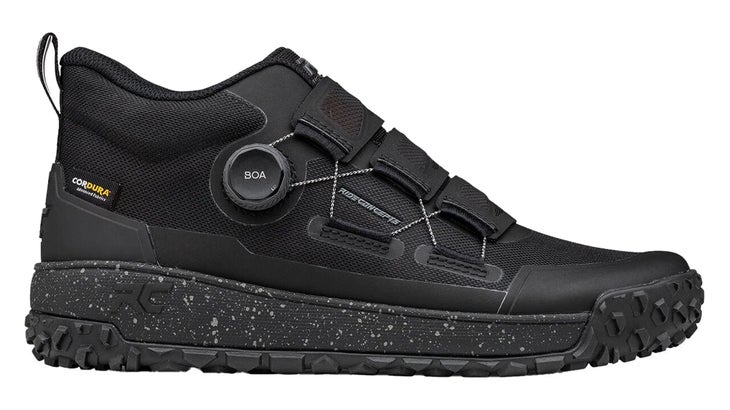
Best Protection: Ride Concepts Tallac Mid BOA
Available sizes: US M 7 – 13
Pros and Cons
⊕ Excellent grip in all conditions
⊕ Mid-height design adds extra protection to ankle
⊕ Easy to adjust fit with BOA® system
⊗ Bulky
When Ride Concepts released these mid-high shoes into the wild last summer, there was much rejoicing from riders demanding a more robust solution for technical gravity riding. The surprisingly roomy mid-volume shoe features BOA’s PerformFit Wrap for a snug fit, and burly Cordura mesh upper with liberal amounts of D3O padding in the ankles, toe, heel, and insoles for bombproof impact resistance. A stiff EVA midsole helps reduce foot fatigue, and an outer sole crafted from RC’s Maxgrip rubber provides secure pedal grip and confident traction off the bike.
The mid-height upper offers greater support than a low-fit shoe, while the gusseted tongue keeps debris at bay like a champ. Surprisingly, the Cordura mesh breathes tolerably well, but the trade-off for all this added material is a much longer break-in period. If you have the patience for that, the reward is a glorious, comfortable fit that offers loads of confidence no matter how gnarly the trail or how much you’re off the bike scouting lines and sessioning techy features.
Best Road Shoes
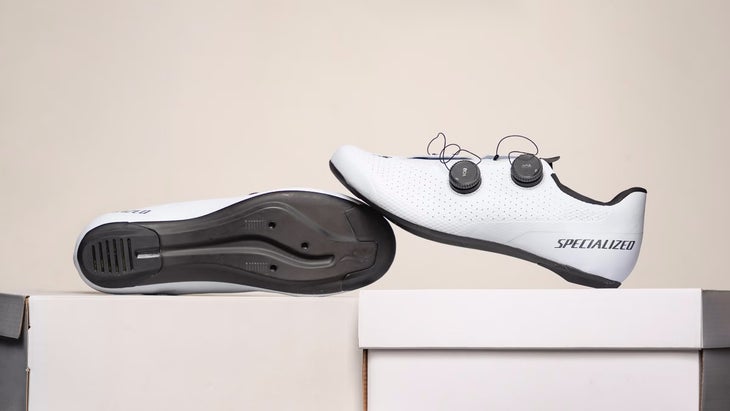
Best Overall:��Specialized Torch 3.0
Available sizes: EU 36-49
Pros and Cons
⊕ Excellent weight
⊕ BOA Li2 dials
⊕ Hard wearing exterior
⊗ Cleat mounts aren’t adjustable
Road cycling shoe prices aren’t just creeping up—they’re skyrocketing. Specialized is part of that trend, but the Torch 3.0 offers a refreshing exception. It’s not quite as performance-oriented as the S-Works Torch ($500), but you’re getting 90 to 95 percent of the performance for significantly less—and with some surprising perks. The Torch 3.0 actually has a better BOA system. Both models use a dual-zone setup and the same pressure-optimized tongue cut, but the S-Works dial doesn’t pop for quick release. The Torch 3.0’s BOA Li2 dials, BOA’s best, make on/off much easier.
Elsewhere, the Torch 3.0 simplifies slightly. The upper is more uniform but still durable and easy to clean. The carbon sole is just as stiff, though slightly heavier and less detailed. It lacks cleat-mount adjustability—but after thousands of foot scans, Specialized says you won’t miss it. (We didn’t during testing.) Bottom line: The Torch 3.0 delivers elite-level performance without the elite-level price.

Best Performance:��Shimano RC903S
Available sizes: 38-47
Pros and Cons
⊕ Supple, form-fitting upper
⊗ Hard to keep clean
Shozaburo Shimano would be proud to know the freewheel company he started in 1921 has grown to showcase a wide range of cycling components and gear for competitive and recreational riders alike, including high-performance cycling shoes like the RC903S, which falls within Shimano’s S-Phyre line.
Dual Boa metal dials lock a rider’s foot into the anti-twist heel cup with the help of the wrap-around upper and six points of retention over the front end of the foot. The carbon sole is strategically reinforced around the cleat for added power transfer while remaining compliant toward the heel for optimal stiffness—rated as 8/10 by our test team who altogether put more than 4,000 miles of riding in these shoes.
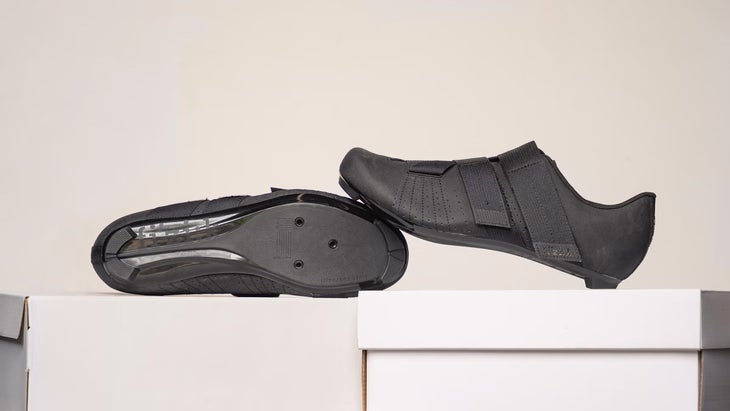
Best On a Budget: Fizik Tempo Powerstrap R5
Available sizes: EU 36-48
Pros and Cons
⊕ Impressive weight for price
⊕ Velcro powerstrap
⊕ Vertical volume in toe box
⊗ Non-adjustable cleat mount
⊗ Narrow fit
Budget road cycling shoes are a tough category—most cut corners so severely they’re no fun to wear. One common compromise? BOA dials. The top-tier Li2 dials are great, but cheaper versions often can’t adjust both ways and don’t pop for quick release.
The Fizik Tempo Powerstrap R5 avoids those issues altogether. It uses the same lightweight, easy-to-adjust Powerstrap system found on Fizik’s higher-end Aeroweave model, and it outperforms many dual-BOA setups: It’s easy to adjust (even mid-ride), lightweight, and offers a snug fit with zero hotspots. The shoe is on the narrow side, typical of older Fizik models, but a tall toe box adds comfort. The carbon-reinforced nylon sole is shaped well enough to feel plenty stiff. The biggest downside: The cleat mount point is fixed and offers limited adjustability.
Still, for this price, we were willing to overlook that shortcoming. The Tempo R5 doesn’t feel cheap—skipping BOA is a smart move here, not an oversight.
Best Gravel Shoes
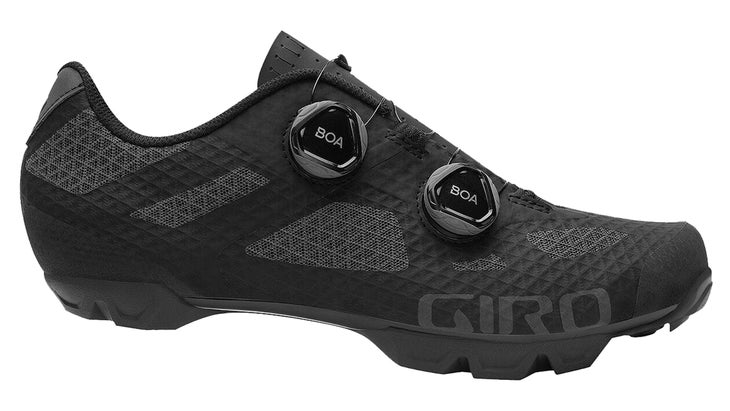
Best Overall: Giro Sector
Available sizes: EU 39 – 50
Pros and Cons
⊕ Lightweight
⊕ Quick drying
⊕ Responsively stiff
⊗ Pricey
⊗ Not ideal off the bike
The Giro Sector is our go-to riding shoe for all types of riding, from laps on our local trails to all-day gravel adventures to XC racing. They offer a nice balance of comfort and stiffness to keep the feet remarkably comfortable regardless of how hard you’re pedaling. The Sector features a one-piece synchwire material upper, dual BOA® adjustment, reinforced toe and heel, and a fairly stiff carbon-composite sole (for pedalling efficiency) with a dual injected rubber outsole with impressively tall lugs for off-the bike traction and pre drilled toe spike mounts.
While the Sector is lightweight and adequately ventilated, it is not the lightest on the market, but it’s by no means portly either. That being said, it gets extra points in comfort, and despite the fragile appearance of the upper, the shoe is surprisingly durable and robust; they show very minimal signs of wear despite extensive testing. If you are a one shoe do-it-all household, we highly recommend the Sector, although it’s happiest pedaling hard.
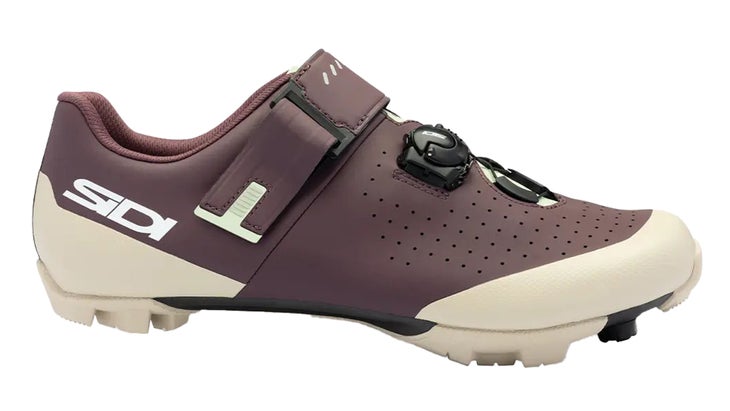
Best Performance: Sidi Physis
Available sizes: EU 36 – 50
Pros and Cons
⊕ Wide toe box
⊕ Excellent power transfer
⊗ Expensive
⊗ Walkability
Brutally efficient and decadently comfortable aren’t descriptive phrases that typically go together. But if you’re describing Sidi’s new Physis shoes, then you’ve pretty much hit the nail on the head. But to tweak an old Keith Bontrager maxim—brutally efficient, decadently comfortable, cheap…pick two—because at $400, these ain’t cheap.
But what you get is what you pay for: Sidi’s legendary Italian craftsmanship mated to modern footwear ergonomics. With the Physis, you get a phenomenally-fitting and well ventilated dual density TPU upper that errs on the roomy side (consider sizing down a half size for Sidi’s legendary glove-like feel while still enjoying the roomy forefoot volume of the Millenium fit), secured with Sidi’s proprietary BOA® type system and their patented Tension Strap over the instep, mated to a X2FC carbon sole so stiff that you might as well be wearing two-by-four planks with a footbed strapped to your feet. Only a two-by-four never screamed performance the way these do; rest assured that every single watt you generate is going right into your pedals. Other details: rubber dimples in the heel cup for a more secure fit. Minimalist abrasion/impact guards around the toe box and heel. Threaded holes at the toes for spikes (CX anyone?).
In essence, these are Ferraris for your feet, but are purpose built for performance gravel and XC riding; if your ride involves any halfway serious hike-a-biking, look elsewhere. But if you’re chasing podiums or KOMs, these are just what the doctor ordered.
How To Choose Bike Shoes
Cycling shoes can be segmented into categories based on their intended use and cleat interface.
Cleats/Clipless Shoes
Road cycling shoes are typically compatible with composite-based, three-bolt style cleats like Shimano’s SPD-SL and Look Delta/Keo. These cleats offer a high amount of retention and have a greater surface area to maximize stability and power transfer per pedal stroke, which is ideal for road cycling. However, the cleats are often exposed and provide poor walkability.
Gravel shoes use a two-bolt pattern for use with cleats like Shimano’s SPD. Two-bolt cleats are generally smaller and made of metal, offering greater durability for walking on uneven surfaces.
Flats
More and more mountain bikers are ditching clipless bike shoes in favor of flats, shoes with sticky rubber soles that offer good grip on pedals and don’t require you to clip in/out of pedals. Many experienced riders and downhillers who navigate high-consequence terrain prefer flats because they allow you to bail off your bike more easily.
Flat shoes are also better choices for novice riders, since they don’t come with a learning curve (getting the hang of clipless shoes and cleats can be tricky). The downside to flats is they don’t offer the same power transfer as clipless shoes.
Budget Versus Performance Cycling Shoes
Don’t disregard your budget. Bike shoes can be exorbitantly expensive, especially on the high-performance end of the spectrum. If you’re looking to get into racing, the higher price tag might be worth it for every additional watt of power. If you’re not racing, we recommend leaning to the more comfortable end of the spectrum, rather than trying to maximize stiffness and performance; these shoes generally come with more palatable price tags.
Materials
Road biking shoes feature lightweight soles made up of carbon or composite materials that blend stiffness and compliance to best suit the rider’s needs. A stiffer sole generally provides higher power transfer; a more compliant shoe flexes more and provides a more comfortable ride, but often equates to more power loss.
Gravel and mountain bike shoes add tread around the sole to improve walkability and stability.
Shoe uppers will consist of a microfiber or knit material with varying amounts of suppleness, ventilation and foot/ankle support. Microfiber uppers tend to provide more durability and support, while knit uppers have a greater amount of ventilation and suppleness.
How Should Bike Shoes Fit?
Fit is critical in a cycling shoe and directly impacts performance. If you can, try before you buy. Your local bike shop may have a selection of bike shoes and employees with a wealth of experience to help you find the right fit. Call around to see what’s available and visit your local bike shop to get a real feel for the shoes before you commit.
How We Test Bike Shoes
- Number of products tested: 21
- Number of Testers: 8
- Number of miles collectively ridden during testing: 12,000
- Biggest ride: 110 miles
Our group of testers, made up of men and women across the country and bike industry experts like and , put 21 pairs of the year’s newest road, gravel, and mountain bike shoes to the test on various rides, races, and trails. Some testers assessed a shoe’s performance while preparing for marquee road and gravel events, while others set out to determine a shoe’s comfort and versatility on their weekly coffee ride.
Our primary testing ground for MTB shoes was mountain biking mecca Hood River, Oregon, where we assessed a shoe’s performance on everything from technical, muddy trails to mellow, meandering cruisers. We graded each pair of shoes we tested on characteristics like stiffness, weight, comfort, and functionality. The shoes on this list impressed our crew in all departments.
Meet Our Lead Testers
Nikki Rohan has been mountain biking for close to 20 years, and testing mountain biking gear for Pinkbike for almost a decade. She resides in Hood River, Oregon, with her husband, two teenagers, a 1-year-old, two dogs, and a grumpy cat. When she is not working, cooking, or parenting, you will find her biking on the local trails.
David Kennedy has been riding road and gravel bikes for 15 years and has been writing about the latest tech in the sport since 2017. He’s toed the line at premier road and gravel events nationwide, including the Belgian Waffle Ride San Diego and the Unbound 200. When he’s not writing or riding, he’s pulling apart bikes at his local shop and connecting with the diverse cycling community around his hometown of Los Angeles.
��is a senior tech editor at Velo. He hails from the Pacific Northwest but when it’s time to ride, hot and dry is better than cold and wet. He will happily talk for hours about the minutiae of cycling tech but understands most people just want things to work. He is a road cyclist at heart and doesn’t care much if those roads are paved, dirt, or digital. Although he rarely races, if you ask him to ride from sunrise to sunset, and beyond, the answer is always yes.
More Bike Gear Reviews
The Best Road Bikes of the Year
The Best Gravel Bikes of 2025
The Best Bike Helmets for Road, Gravel, and Trail Riding


